
Running a giveaway on Instagram isn't just a trend, it's a proven method to boost engagement, increase followers, and build brand awareness. But how does one navigate the process effectively? It's not as daunting as it may seem.
Firstly, it's essential to understand the mechanics of a successful Instagram giveaway. It's more than just posting a prize and waiting for the likes to roll in. There's strategy involved, from selecting the right prize to crafting a compelling call-to-action.
Lastly, it's important to know the rules. Instagram has guidelines for contests and giveaways that you'll need to follow. Ignoring these could lead to your giveaway being shut down or worse, your account being suspended. So, let's dive into the world of Instagram giveaways and discover how to run one successfully.
Understanding the Basics of a Instagram Giveaway
Possessing a thorough understanding of the basics of an Instagram giveaway is vital for anyone intending to use this strategy. Delving into the mechanics of these social media contests allows businesses to extract maximum value without stumbling over unforeseen pitfalls.
Defining Your Giveaway Goals
Before one ventures into the world of Instagram giveaways, it's critical to clearly define what the end objective is. Whether it's increasing followership, sparking engagement, raising brand awareness or instigating user-generated content, these objectives should be vivid and measurable. It's these goals that'll inform the type of giveaway to run, the ideal prize, and the primary call-to-action.
When setting goals, one should consider factors such as:
- The target demographic: a clear understanding of the target audience will dictate the kind of prize that'll be appealing and subsequently, successful.
- The desired growth number: this helps in tracking the success of the giveaway.
Like any other platform, Instagram has its own set of promotion guidelines that marketers ought to strictly adhere to. Neglecting these rules could result in unpleasant repercussions like having the giveaway shut down or the account suspended. Familiarize yourself with these guidelines located under Instagram's policy section; they're regularly updated and provide comprehensive information on how to legally run promotions on the platform.
Key guidelines include:
- Acknowledging that the promotion is not sponsored, endorsed, administered by, or associated with Instagram.
- Providing clear and concise rules that follow Instagram's community guidelines.
By defining the end goals and understanding Instagram's promotion rules, brands can confidently orchestrate giveaways that drive the desired results. This foundational knowledge lays the groundwork for more focused strategies that'll revisit throughout the article.
Planning and Preparation
Preparing for an Instagram giveaway involves much more than just choosing a prize and announcing the contest. It requires meticulous planning and attention to details. It's necessary to decide on a prize appealing to the target audience, outline an entry process, and establish the timeline along with the rules of the giveaway. By detailing these factors thoroughly, brands can ensure a smooth-running giveaway that energizes their audience and delivers tangible results.
Deciding on the Prize
The centerpiece of any successful giveaway is, naturally, the prize. The prize can make or break a giveaway - it's what grabs people's attention and incentivizes them to participate. Therefore, it must resonate with the target audience. It could be a popular product, a bundle of products, or an exclusive experience related to the brand. In other words, the prize should reflect the brand's value while also catering to its audience's preferences.
Outlining the Entry Process
Next up is defining the entry process. This process should strike a balance between simplicity and effectiveness. Users wouldn't participate if the process is too taxing or confusing. On the other hand, using a simple hashtag or becoming a follower might not fully harness the brand-building potential of a giveaway. A well-rounded entry process might include steps like:
- Following the brand's account
- Liking and commenting on the giveaway post
- Tagging friends in the comments
- Sharing the post on their own Instagram stories
By leveraging multiple user actions, businesses can optimize their reach while also keeping the entry process user-friendly.
Establishing the Timeline and Rules
Finally, it's crucial to clearly communicate the rules and timeline of the giveaway. The timeline should be long enough to allow a good number of entries but not too long that users lose interest. Rules, too, should be understandable and easily accessible. They should comply with Instagram's policies and highlight key points like eligible regions, how and when winners will be chosen, and any age or other restrictions.
Drafting detailed rules may seem daunting, but it's necessary to guard against potential problems and ensure a fair process. Thus, in the planning phase, brands should consider:
- The starting and ending dates of the giveaway
- How entries will be counted and reviewed
- The date and method of announcing the winner
Running an Instagram giveaway might seem like a fun and spontaneous event, but successful ones are anything but. They need thought, strategy, and, above all, planning.
After the groundwork's been set for the Instagram giveaway, it's time for a crucial aspect: promotion. How a brand drives traffic to its contest can make or break its success. This involves crafting compelling posts, leveraging hashtags and influencers, and utilizing cross-promotion strategies.
Crafting Compelling Giveaway Posts
For an Instagram giveaway to be successful, it's essential to create compelling posts that engage the brand's audience. This starts with a high-quality image or video that immediately grabs attention. This might be the product up for grabs, an interesting graphic, or a short clip of someone using the prize. Captions are another important element. They should be brief and enticing, providing a quick overview of the prize and clear instructions for entry.
To boost engagement, it's recommended to encourage users to like, comment, or share the post as part of the contest rules. Companies could consider incorporating engagement-facilitating elements in their post such as "Tag two friends who you'd love to share this prize with!" or "Double your chances of winning by sharing this post on your story!".
Hashtags play a big role in Instagram discovery. They can greatly increase the reach of your giveaway by bringing it in front of users who may not be following your account. Come up with a unique hashtag for your giveaway, something that encapsulates the essence of your brand or the giveaway itself. This could be as simple as #YourBrandNameGiveaway or something more creative. Popular giveaway-related hashtags like #giveaway and #contest can also attract more participants.
Influencer partnerships can bring enormous benefits to an Instagram giveaway. Influencers generally have large, engaged audiences that trust their recommendations. Working with influencers, preferably those in your industry or niche, can give your giveaway a significant visibility boost.
Finally, enlist the help of other social media platforms to build buzz around an Instagram giveaway. Facebook, Twitter, LinkedIn, and email newsletters can be valuable tools to spread the word about your contest. Brands can share a link to the giveaway post or simply post a brief teaser about the giveaway on these platforms.
Cross-promotion isn't limited to the digital world. There's value in leveraging offline marketing avenues – think catalogs, mailers, brick-and-mortar stores. By integrating online and offline initiatives, brands can fully exploit the promotional potential of an Instagram giveaway.
By implementing these tactics, companies move closer to a more successful and impactful Instagram giveaway. The road certainly doesn't end there but these strategies set a solid foundation to attract participants and hopefully, convert them into lasting followers. As a brand ventures forth in planning their giveaway, it's vital to remember that fine-tuning and adjusting strategies based on response and engagement metrics can help optimize the overall results.
Managing the Giveaway
Ensuring an Instagram giveaway runs efficiently and effectively also involves managing the giveaway itself. This can include monitoring engagement, ensuring fair play, and selecting and announcing the winner. Let's delve further into these crucial aspects.
Monitoring Engagement
To gauge the success of the giveaway, and to make any necessary adjustments, it's important to actively monitor participant engagement. Check for spikes in the number of followers, likes, shares, or comments. It's also crucial to keep an eye on the quality of interactions - are they genuine, are they from your target market? There are numerous analytics tools available that can assist in tracking these vital statistics. But remember, it's not just about the numbers. Engagement quality matters too.
Ensuring Fair Play
Fair play is crucial in running a successful Instagram giveaway. Not only does it keep participants satisfied, but it also ensures that your brand maintains credibility and upholds Instagram's terms and conditions. To ensure fairness, clearly state the rules and criteria from the start, and consistently apply them throughout the giveaway. It's also a good idea to use a third-party app or service to help manage entries and keep everything fair and transparent.
Selecting and Announcing the Winner
Selecting the winner can be one of the most exciting parts of the giveaway. It's essential to choose a winner based on the defined criteria and to announce it in a timely and festive manner. One common method for selection is to use a random generator tool, providing an unbiased and transparent process. Once the winner is chosen, announce it to your followers with an engaging post, and make sure to congratulate the winner personally. Remember, successful giveaways can lead directly to increased brand loyalty and user engagement, so make the most of this opportunity to delight your audience.
Post-Giveaway Activities
The thrill of a giveaway doesn't end the moment a winner is chosen. What occurs after the reward's claimed can provide valuable insights that can shape future campaigns. May it be about analyzing the results, engaging with the participants, or learning from your audience's feedback; these are crucial elements in the post-giveaway period.
Analyzing the Giveaway’s Success
Once the winner's been announced and the hype's started to cool, it's time to delve into the data. This helps in understanding how your giveaway performed and what sections you may need to improve. The primary metrics to check include participation rate, engagement level, the number of new followers gained, and essentially, if it brought you closer to your initial giveaway goals.
Let's look at these metrics in a more detailed manner:
| Metric | Description |
|---|
| Participation Rate | It gauges how many people entered the giveaway. |
| Engagement Level | It shows the level of interaction on the giveaway post (likes, comments, shares). |
| New Followers Gained | It indicates how many new followers came through the giveaway. |
| Giveaway Goals Achieved | It determines if your target goals have been met. |
Remember, each giveaway is a learning experience, and results will differ based on your audience, the prize offered, and the overall execution.
Engaging with Participants After the Event
Participants who didn't win might be disappointed, but keeping them engaged even after the event can transform those feelings in a positive way and retain them as followers. The after-giveaway period is a prime time to interact with your audience via post-event follow-ups, thank you messages, and showcasing the winner and their prize.
This is not just about damage control, but a chance to build further rapport with your audience and inspire loyalty. Future content could feature the winner using the prize, feedback on the event, or even flash deals just for participants.
Learning from Feedback for Future Giveaways
Nothing's perfect; not even a well-planned Instagram giveaway. There will always be areas of improvement. Understanding what worked and what didn't is crucial and will only lead to better results in the future. That's why taking feedback from participants is an absolute must.
Perhaps your audience thinks the giveaway could have been promoted better, or the rules were too tricky, or even that the prize didn't align with their interests. Gathering this feedback lets you continually evolve your strategy, ensuring that each giveaway you conduct outperforms the previous one.
With these insights, it's clear that what happens behind the giveaway scenes is just as important as the event itself, equipping you for success with your future Instagram giveaways. Line your next giveaway up for success by taking advantage of these valuable post-giveaway activities.
Conclusion: Maximizing Your Instagram Giveaway's Impact
Running a successful Instagram giveaway isn't just about the event itself. It's about the strategic planning, careful execution, and insightful analysis that surround it. It's about understanding Instagram's guidelines, creating compelling posts, and leveraging the power of hashtags and influencers. It's about fair play, active monitoring, and timely winner announcement. But most importantly, it's about engaging with your audience and building lasting relationships.
Post-giveaway activities, like analyzing metrics and gathering feedback, are just as important as the giveaway itself. They're what help you understand your audience better, improve your strategies, and achieve your goals. They're what turn a simple giveaway into a powerful tool for growth and engagement. So don't just run a giveaway. Maximize its impact. And remember, every giveaway is a learning opportunity. Use it wisely.
If you want to run an Instagram giveaway, then you need to use the most powerful and simple-to-use software on the market, Raffle Leader.

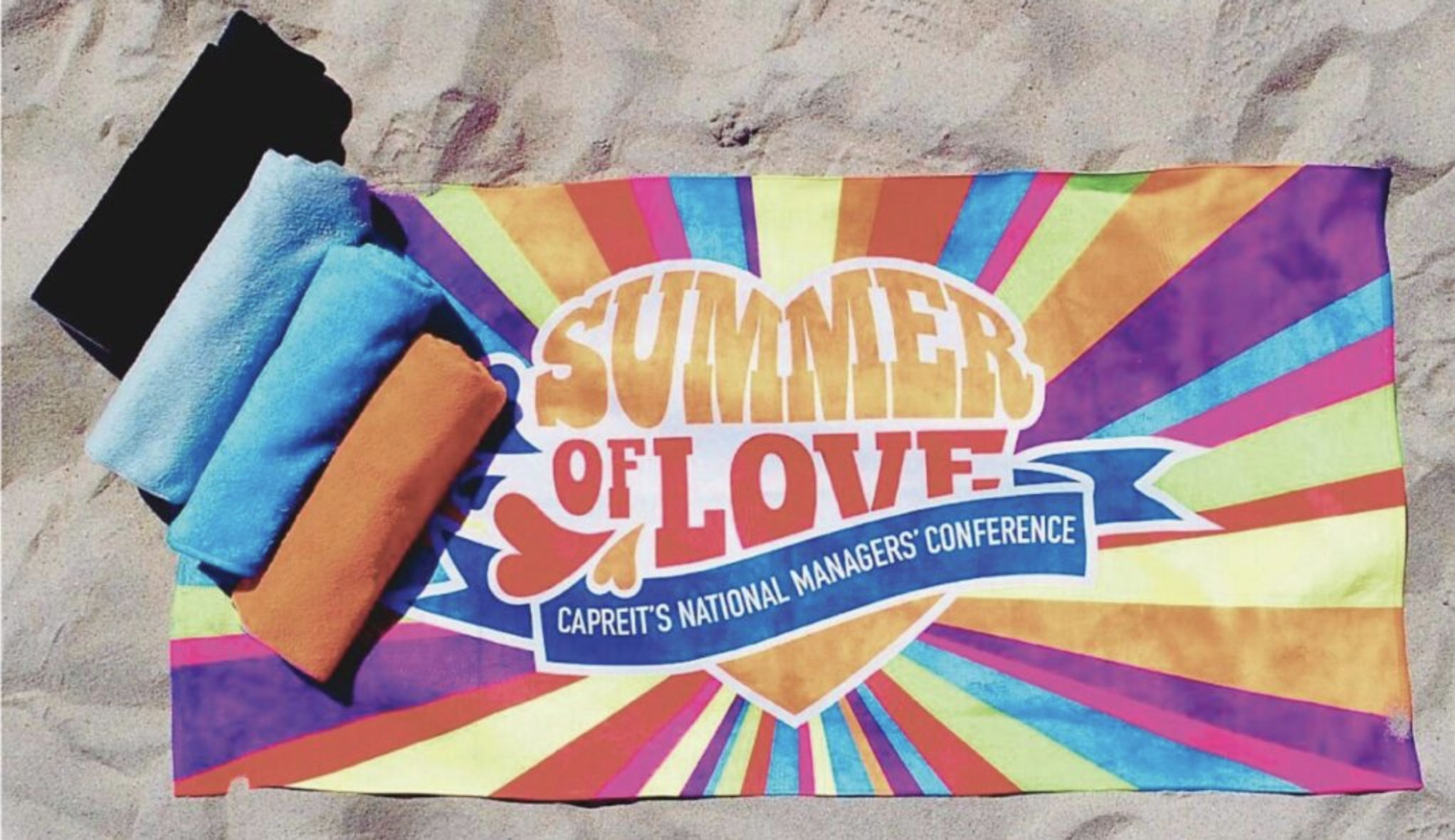 Custom beach towels are a popular choice for summer giveaways. They provide excellent branding opportunities during beach trips and vacations. These towels also offer high visibility for your logo, making them effective promotional products.
Custom beach towels are a popular choice for summer giveaways. They provide excellent branding opportunities during beach trips and vacations. These towels also offer high visibility for your logo, making them effective promotional products.  Branded water bottles are practical and appreciated by customers, especially during the hot summer. They promote hydration and offer long-lasting brand exposure as customers use them repeatedly. Including your logo on water bottles can enhance brand recall and visibility.
Branded water bottles are practical and appreciated by customers, especially during the hot summer. They promote hydration and offer long-lasting brand exposure as customers use them repeatedly. Including your logo on water bottles can enhance brand recall and visibility. Offering sunscreen with your brand's logo helps protect your customers' skin while promoting your brand. These eco-friendly promotional items show your commitment to health-conscious branding and environmental sustainability. They are perfect for summer giveaways at outdoor events and beach activities.
Offering sunscreen with your brand's logo helps protect your customers' skin while promoting your brand. These eco-friendly promotional items show your commitment to health-conscious branding and environmental sustainability. They are perfect for summer giveaways at outdoor events and beach activities. Sunglasses with your logo are stylish and helpful, making them ideal for various outdoor events. They are a popular giveaway item that offers high visibility for your brand. Customers appreciate the practicality of sunglasses, which also serve as a fashionable accessory.
Sunglasses with your logo are stylish and helpful, making them ideal for various outdoor events. They are a popular giveaway item that offers high visibility for your brand. Customers appreciate the practicality of sunglasses, which also serve as a fashionable accessory. Portable fans are convenient for summer events and travel. They are practical giveaways that customers will appreciate, especially during hot days. Branding these fans with your logo ensures that your brand is associated with comfort and convenience.
Portable fans are convenient for summer events and travel. They are practical giveaways that customers will appreciate, especially during hot days. Branding these fans with your logo ensures that your brand is associated with comfort and convenience. Customized flip-flops are fun and light-hearted, perfect for casual summer wear. They are used frequently, providing everyday use and brand promotion. Flip-flops with your logo can enhance brand visibility in a relaxed and enjoyable setting.
Customized flip-flops are fun and light-hearted, perfect for casual summer wear. They are used frequently, providing everyday use and brand promotion. Flip-flops with your logo can enhance brand visibility in a relaxed and enjoyable setting. Branded picnic sets encourage outdoor dining and community engagement. They are comprehensive and memorable gifts, including blankets, plates, and utensils. These sets promote your brand while supporting outdoor activities and gatherings.
Branded picnic sets encourage outdoor dining and community engagement. They are comprehensive and memorable gifts, including blankets, plates, and utensils. These sets promote your brand while supporting outdoor activities and gatherings. Eco-friendly tote bags promote sustainability and are convenient for carrying summer essentials. They appeal to environmentally conscious consumers and highlight your commitment to eco-friendly practices. These reusable bags are perfect for summer shopping and outings.
Eco-friendly tote bags promote sustainability and are convenient for carrying summer essentials. They appeal to environmentally conscious consumers and highlight your commitment to eco-friendly practices. These reusable bags are perfect for summer shopping and outings. Partnering with local shops to offer ice cream vouchers provides a sweet treat for your customers. This giveaway creates positive brand associations and encourages customer interaction. Ice cream vouchers are an enjoyable way to engage with your audience during the summer.
Partnering with local shops to offer ice cream vouchers provides a sweet treat for your customers. This giveaway creates positive brand associations and encourages customer interaction. Ice cream vouchers are an enjoyable way to engage with your audience during the summer. Branded frisbees or beach balls encourage outdoor activities and audience interaction. These fun and engaging outdoor games make them perfect for summer events. They help promote your brand while encouraging active participation.
Branded frisbees or beach balls encourage outdoor activities and audience interaction. These fun and engaging outdoor games make them perfect for summer events. They help promote your brand while encouraging active participation. Seed packets are a unique and sustainable giveaway encouraging gardening and brand growth. These items are appreciated by customers who enjoy gardening and environmental sustainability. Seed packets with your logo help grow your brand's presence meaningfully.
Seed packets are a unique and sustainable giveaway encouraging gardening and brand growth. These items are appreciated by customers who enjoy gardening and environmental sustainability. Seed packets with your logo help grow your brand's presence meaningfully. Offering festival tickets as prizes generates excitement and buzz around your brand. Engaging with local events and communities through festival tickets helps increase your brand's visibility and appeal. These tickets are an exciting and valuable giveaway that attracts attention.
Offering festival tickets as prizes generates excitement and buzz around your brand. Engaging with local events and communities through festival tickets helps increase your brand's visibility and appeal. These tickets are an exciting and valuable giveaway that attracts attention.


 Alternatively, you can offer customers an upgraded version of something they already have rather than providing something entirely new. Imagine you're a SaaS business gearing up to launch a refer-a-friend program. Consider rewarding customers for each successful referral with free cloud storage space, similar to
Alternatively, you can offer customers an upgraded version of something they already have rather than providing something entirely new. Imagine you're a SaaS business gearing up to launch a refer-a-friend program. Consider rewarding customers for each successful referral with free cloud storage space, similar to 
 Another way to encourage customers to join your refer-a-friend program is by hosting a referral contest. Referral contests work by placing a contest widget on your website for individuals to enter. This widget provides various entry options for users and grants them entries for completing small tasks, like sharing the contest on Facebook or subscribing to your email list. One fantastic example is the referral contest organized by clothing retailer
Another way to encourage customers to join your refer-a-friend program is by hosting a referral contest. Referral contests work by placing a contest widget on your website for individuals to enter. This widget provides various entry options for users and grants them entries for completing small tasks, like sharing the contest on Facebook or subscribing to your email list. One fantastic example is the referral contest organized by clothing retailer 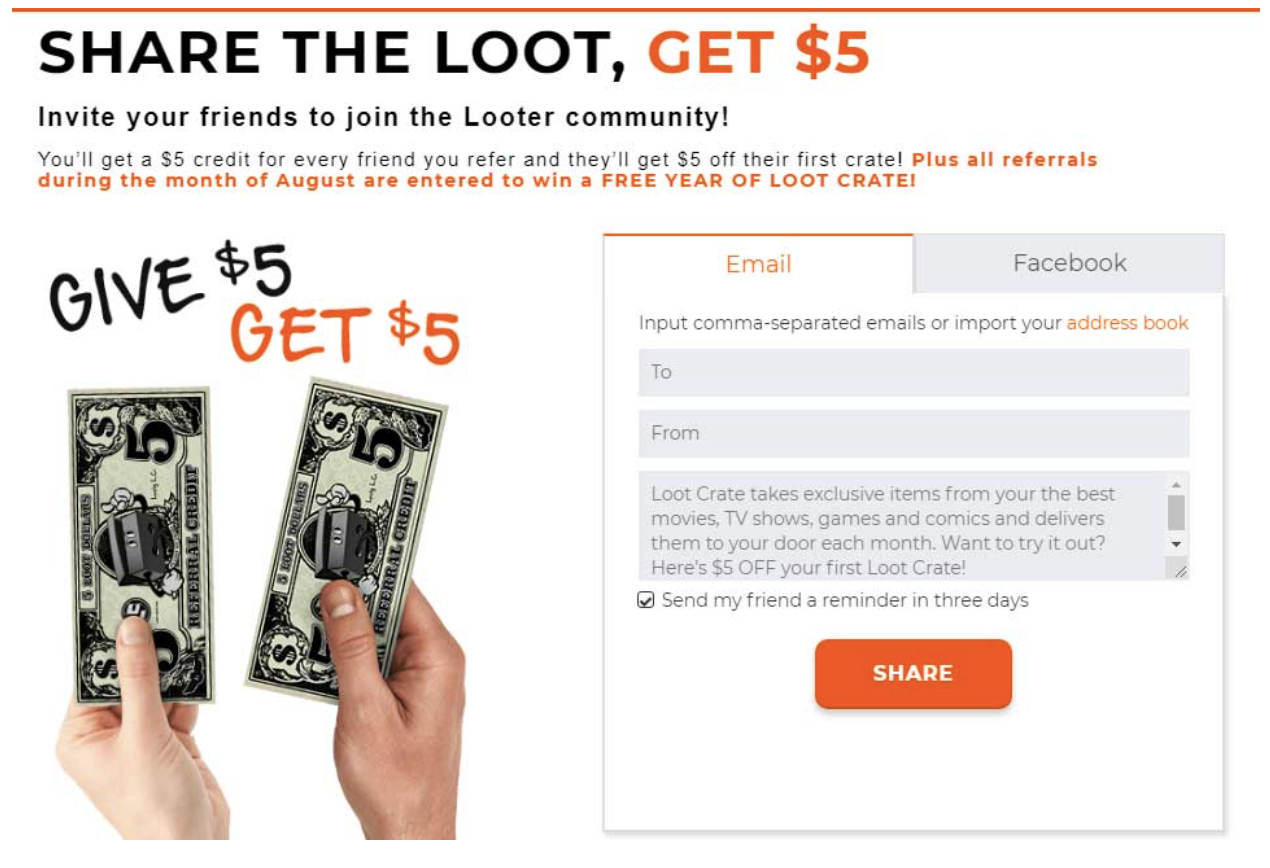 This refer-a-friend promotion idea is a hybrid, as it uses a combination of different reward structures. Like many addictive games and apps, a gamified referral campaign encourages customers to progress through various levels. More referrals mean more rewards and achievements unlocked. For example, Loot Crate, a gaming subscription box, integrated gamified rewards into its referral program. Customers receive $5 for every referral and get a chance to win a free year of Loot Crate! Why It Works Gamified refer-a-friend campaigns maximize the addictive nature of mobile games to encourage continuous engagement and referrals. With endless possibilities, you can enhance the gaming experience by assigning titles to each level and awarding virtual badges. Introducing a leaderboard fosters friendly competition, allowing customers to track their referrals over various timeframes. Lastly, integrating mystery gifts, exclusive memberships, and contests increases excitement in your refer-a-friend program.
This refer-a-friend promotion idea is a hybrid, as it uses a combination of different reward structures. Like many addictive games and apps, a gamified referral campaign encourages customers to progress through various levels. More referrals mean more rewards and achievements unlocked. For example, Loot Crate, a gaming subscription box, integrated gamified rewards into its referral program. Customers receive $5 for every referral and get a chance to win a free year of Loot Crate! Why It Works Gamified refer-a-friend campaigns maximize the addictive nature of mobile games to encourage continuous engagement and referrals. With endless possibilities, you can enhance the gaming experience by assigning titles to each level and awarding virtual badges. Introducing a leaderboard fosters friendly competition, allowing customers to track their referrals over various timeframes. Lastly, integrating mystery gifts, exclusive memberships, and contests increases excitement in your refer-a-friend program.





 The Essentials plan is best for small businesses, while the Professional and Premium plans offer additional features like custom domains, advanced logic, and higher response limits.
The Essentials plan is best for small businesses, while the Professional and Premium plans offer additional features like custom domains, advanced logic, and higher response limits.
 Survicate offers a free plan with limited responses and paid plans starting from $99/month.
Survicate offers a free plan with limited responses and paid plans starting from $99/month.
 Integrations Userflow integrates with popular analytics tools like Amplitude, Mixpanel, Segment, and Heap to stream survey response data. It also connects with CRMs such as Salesforce and HubSpot.
Integrations Userflow integrates with popular analytics tools like Amplitude, Mixpanel, Segment, and Heap to stream survey response data. It also connects with CRMs such as Salesforce and HubSpot.
 Integrations SurveyJS stores survey metadata and results in JSON format, allowing integration with any server or database. It can be fully integrated into your IT infrastructure for a self-hosted form management system.
Integrations SurveyJS stores survey metadata and results in JSON format, allowing integration with any server or database. It can be fully integrated into your IT infrastructure for a self-hosted form management system.
 Integrations Mailchimp offers over 300 integrations with popular tools and services, including:
Integrations Mailchimp offers over 300 integrations with popular tools and services, including:

 Integrations SurveyMonkey connects with various tools, including:
Integrations SurveyMonkey connects with various tools, including:

